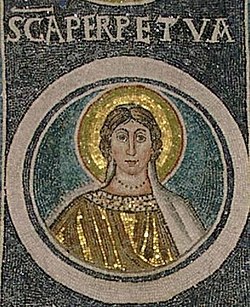Perpetua and Felicity
Pre-congregation | |
|---|---|
| Feast |
|
Perpetua and Felicity (
The
Imprisonment
Perpetua's account opens with conflict between her and her father, who desires that she
Perpetua described the physical and emotional torments that she suffered in the prison leading up to her martyrdom. Perpetua suffered physically due to the heat, rough prison guards, and the cessation of regular breastfeeding. Perpetua also described how the prison conditions improved after she was able to bribe the guards so that she and the other martyrs were moved to another part of the prison, with her infant. Her physical torment was also eased after she was able to breastfeed her child.[9] Perpetua described bodily ailments in detail and the most common in her narrative was the cycle of pain and relief she would feel in her breasts.
At the encouragement of her brother, Perpetua asks for and receives a vision, in which she climbs a dangerous ladder to which various weapons are attached. At the foot of a ladder is a serpent, which is faced first by Saturus and later by Perpetua. The serpent does not harm her, and she ascends to a garden. At the conclusion of her dream, Perpetua realizes that the martyrs will suffer.
The day before her martyrdom, Perpetua envisions herself defeating a savage Egyptian and interprets this to mean that she would have to do battle not merely with wild beasts, but with the Devil as well.
Veneration

In Carthage a basilica was erected over the tomb of the martyrs, the Basilica Maiorum, where an ancient inscription bearing the names of Perpetua and Felicitas has been found.
Saints Felicitas and Perpetua are among the martyrs commemorated by name in the Roman Canon of the Mass.
The
Other churches, including the
Perpetua and Felicity are
In the
See also
- Domnina, Berenice, and Prosdoce
- List of Christian women of the patristic age
References
- ^ a b Great Synaxaristes: (in Greek) Ἡ Ἁγία Περπέτουα ἡ Μάρτυς καὶ οἱ σὺν αὐτῇ. 1 Φεβρουαρίου. ΜΕΓΑΣ ΣΥΝΑΞΑΡΙΣΤΗΣ.
- ^ a b Martyr Perpetua, a woman of Carthage. OCA – Feasts and Saints.
- ^ "The Calendar" (PDF). Church of England. Retrieved 11 March 2016.
- ^ Lutheran Woman Today, Volume 11. Publishing House of Evangelical Lutheran Church in America. 1998.
Perpetua is commemorated by the church on March 7.
- ^ Salisbury, Joyce Ellen (3 March 2019). "Perpetua: Christian Martyr". Encyclopædia Britannica. Retrieved 7 July 2019.
- ^ a b Melissa, Perez. Vibia Pertetua's Diary: A Woman's Writing in a Roman Text of Its Own (PDF) (Thesis). Archived from the original (PDF) on 16 January 2022. Retrieved 6 January 2021.
She was "of good family, recently married, and well educated with an infant son at her breast."
- ISBN 9780199777570.
- ISBN 9780195385458.
- S2CID 164888397.
- ^ "Calendarium", p. 89
- ^ "Calendarium", p. 119
- ^ "The Calendar". The Church of England. Retrieved 27 March 2021.
- ISBN 978-1-64065-234-7.
- ^ Holy Trinity Russian Orthodox Church
